The MGA With An Attitude
TIMING COVERS, SEALS and OIL THROWERS - CS-201
At 07:30 PM 11/4/02 -0800, Doug Lawrence wrote:
>"I need the magic part to stop the infamous oil leak. What I'm looking for is the timing chain cover that fits the late MGA MkII or early (to '68) MGB. This cover uses a neoprene seal instead of the felt seal."
Yup, I have one on every engine I own and have installed one on every engine that has passed through my hands, but I don't have any spares at the moment. Also make note that the MGA Mk-II timing cover is not the same as the early MGB timing cover. They are all interchangeable, but only if you use the correct oil thrower ring inside. I will start with description of the earliest parts first and then work into the later parts.
 Picture at right shows the most common timing cover fit to the MGA starting at engine number GB259. The first 158 engines, from GB101 to GB258, did not have a timing chain tensioner. Those early timing covers were a simple pear shape without the small bump on the side. That is the model shown in Section A of the workshop manual. In the early pages of the manual there is no mention of the tensioner, not even in the instruction for installation and alignment of the timing chain. First appearance of the tensioner in the manual is in the illustration of the camshaft and crankshaft and oil pump components. First instruction for the tensioner is in Section A.32.
Picture at right shows the most common timing cover fit to the MGA starting at engine number GB259. The first 158 engines, from GB101 to GB258, did not have a timing chain tensioner. Those early timing covers were a simple pear shape without the small bump on the side. That is the model shown in Section A of the workshop manual. In the early pages of the manual there is no mention of the tensioner, not even in the instruction for installation and alignment of the timing chain. First appearance of the tensioner in the manual is in the illustration of the camshaft and crankshaft and oil pump components. First instruction for the tensioner is in Section A.32.
Notice the outer bolt flange is flat except for a small stiffening ridge turned up at the outside edge. Assembly calls for oval flat washers to be used to spread the load of the bolt over a larger area of the flange to reduce puckering of the metal around the holes. This pucker will inevitable occur to some extent anyway. Any time the cover is being re-installed you should tap down the raised metal around the holes with a flat faced hammer, and use a straight edge to check for flatness. If the puckered condition is left in place it may prevent sealing of the gasket.
These early timing covers (and most of MGA production) use a felt seal fitting into a packing gland in the cover (installation described in a prior lesson). See pictures below (click for larger pictures). The cover is slightly more than 1-1/2 inches thick (about 1.52) back flange to front face without a gasket. The area around the seal protrudes 3/16 inch ahead of the surrounding flat surface. The large area in front of the camshaft sprocket (where it is stamped "MOWOG") has a very shallow inward dish shape to serve as a stiffener which reduces vibration and noise. Timing pointers are on the bottom with three fingers at 5 degree increments. Going clockwise the third finger is longer and pointing straight down to indicate Top Dead Center for timing, with the other pointers being 5 and 10 degrees Before Top Dead Center.
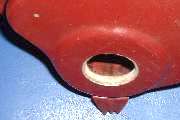 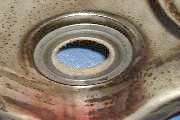 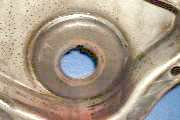
Looking inside the cover ( above center), the formed packing gland is soldered in place and is slightly more than 1/4 inch thick (about 0.26) including thickness of the outer shell. This is then approximately flush with the inside surface of the shell, leaving a 1-1/4 inch inside space from the gasket flange. It also leaves an inside pocket (a moat) surrounding the packing gland 3/16 inch deep. The picture above right shows the oil thrower ring positioned inside the timing cover, completely covering the packing gland.
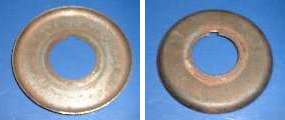 The oil thrower ring shown at right has a cup shape edge extending 3/16 inch forward, which extends into the pocket area around the packing gland. This disk is captured between the crankshaft timing sprocket and the hub of the front pulley, so it rotates with the crankshaft but does not touch the cover. (If the oil thrower ring is installed backward it will substantially interfere with the timing chain). When the engine is running this spinning ring throws oil away from the packing gland (flying off the front edge of the ring). Any oil running down the inside face of the timing cover is trapped in a groove surrounding the packing gland, and is therefore guided around the packing area to the bottom of the cover where it can return to the sump via a drain hole in the main bearing cap. As oil may puddle inside the bottom of the timing cover it is once again thrown away by the spinning disk. As such, you can think of the oil thrower as being a mechanical seal, while the felt packing is more of a dust excluder. This is actually very effective for keeping oil inside the engine while it is running (as long as there is no pressure in the crankcase).
The oil thrower ring shown at right has a cup shape edge extending 3/16 inch forward, which extends into the pocket area around the packing gland. This disk is captured between the crankshaft timing sprocket and the hub of the front pulley, so it rotates with the crankshaft but does not touch the cover. (If the oil thrower ring is installed backward it will substantially interfere with the timing chain). When the engine is running this spinning ring throws oil away from the packing gland (flying off the front edge of the ring). Any oil running down the inside face of the timing cover is trapped in a groove surrounding the packing gland, and is therefore guided around the packing area to the bottom of the cover where it can return to the sump via a drain hole in the main bearing cap. As oil may puddle inside the bottom of the timing cover it is once again thrown away by the spinning disk. As such, you can think of the oil thrower as being a mechanical seal, while the felt packing is more of a dust excluder. This is actually very effective for keeping oil inside the engine while it is running (as long as there is no pressure in the crankcase).
When the engine is shut down any remaining oil running about inside the timing cover should simply drain back to the sump, as the felt packing piece is higher than the bottom of the cover. Even in the event that the felt packing piece may become significantly worn or loose, the mechanical seal will still work. If your engine is oozing oil at this point while running, it is likely that the piston rings are worn and allowing excessive blow-by of combustion gasses to pressurize the sump. This might also be a problem with any engine run with inadequate crankcase ventilation.
Be careful not to pry against the face of the timing cover when removing the crankshaft pulley. If you bend the cover and packing gland back a bit it may rub on the oil thrower ring (or damage the ring).
In April 1962, at engine number 16GC-8263 (less than 600 units before end of production), the timing cover was modified to carry a rubber lip seal in place of the prior felt packing piece (pictures below). I have seen this cover on a number of earlier 1600 and 1622 engines, so the records may not be clear on the change over point.
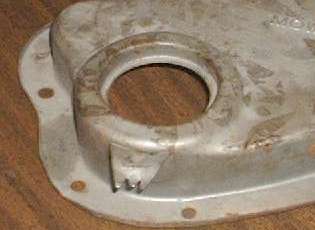
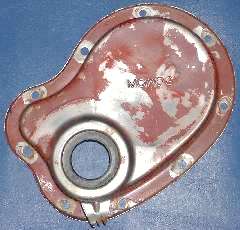
This is a simpler timing cover formed with single sheet metal stamping, and no soldering required for the packing gland. The overall diameter of the round boss on the front is the same, but it is pushed forward about 1/8 inch more with the cover main flat face in the same position as the first cover. The center has a pocket formed to nearly 3/8 inch depth to hold the rubber seal, which is inserted from the front. This could (in theory) allow the seal to be changed after removing the crankshaft pulley but without removing the timing cover from the engine (gasket not leaking being a rash assumption). A seal being 3/8 inch thick will extend very slightly in front of the cover, about 1/32 inch (below left). This cover, like the first, has a flat bolt flange with a stiffening ridge around the edge.
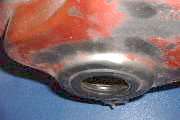 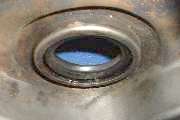 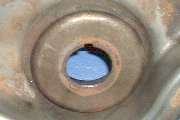
Looking inside (center picture) there is the formed cup surrounded by a moat similar to the first cover. The back face of the seal pocket has about the same distance from the gasket flange, so the oil thrower fits in the same location on the crankshaft. A difference here is that the surrounding pocket (the moat) is much deeper (cover extending farther forward). The Servicc Parts List says the oil thrower ring changed at the same time as the timing cover, old ring 1A1546, new ring 12H775. By the space allowed the oil thrower could have been smaller diameter and deeper, but in fact the same oil thrower will fit and will probably work just as well with the newer timing cover.
Addendum April 2011:
Mark Darley sends the following picture (a total surprise to me). This oil thrower ring appears to be an intermediate design, possibly intended for use with the late mode MGA (or very early MGB) rubber seal timing cover shown above.
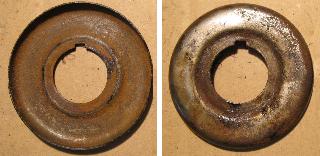 This one has the cup shape similar to the one above, but also has an offset center hub that will position the outer part of the ring farther back, closer to the timing chain (similar to the flat ring that comes with later design). This may be the part number 12H775 noted as new with introduction of the timing cover with rubber seal.
This one has the cup shape similar to the one above, but also has an offset center hub that will position the outer part of the ring farther back, closer to the timing chain (similar to the flat ring that comes with later design). This may be the part number 12H775 noted as new with introduction of the timing cover with rubber seal.
This timing cover as fit to the late production MGA 1600 MK-II is a very rare bird indeed. I had at time of first writing only seen one of these not on an original 1622 engine, and it is currently on my spare 1500 engine (sometimes in my car depending on circumstances). I procured it from an all-British bone yard in the mid 1990's. It was sort of an accident when I was asking for the early MGB cover and the yard gave me this one, because they knew I had the MGA. This particular cover is a direct replacement for the earlier MGA cover with felt seal, and it can use the same oil thrower. The rubber seal is the same one used in the MGB. Seeing another such timing cover on a non-1622 engine in Mid January 2005 prompted me to take more pictures and measurements and revise this web page. This one is part of an early 1800 engine about to go into a friend's MGA. It is accompanied by the correct dished oil thrower, as some of the very early MGB engines were equipped that way from the factory.
Addendum March 2009: Having seen more early MGB engines with the external seal type cover, I believe it was used at least through the 18GA engines (to mid 1964), and most likely also through the 18GB engines (last half of 1964 production). First use of the internal seal cover was likely with the 18GB engine, the first five main bearing engine (1965 model year).
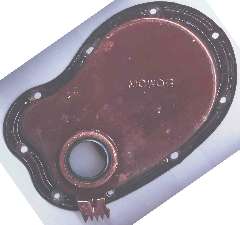 The early MGB timing cover is more common and in more plentiful supply and can also be used on the MGA. Starting with (or slightly before) the 1965 model with 18GB engine, the timing cover is formed differently, with the rubber seal pressed in from the inside of the cover, so the cover must be removed to replace the seal. This cover is also slightly thinner and flat faced with the seal nest extending forward from the face (no large moat around the seal), so you also have to use the different (almost flat) oil thrower ring from the MGB (1965 and later).
The early MGB timing cover is more common and in more plentiful supply and can also be used on the MGA. Starting with (or slightly before) the 1965 model with 18GB engine, the timing cover is formed differently, with the rubber seal pressed in from the inside of the cover, so the cover must be removed to replace the seal. This cover is also slightly thinner and flat faced with the seal nest extending forward from the face (no large moat around the seal), so you also have to use the different (almost flat) oil thrower ring from the MGB (1965 and later).
DO NOT use the original cup shaped MGA oil thrower with the later model MGB cover. This will rub and quickly chew a circular slot through the face of the cover making for a much worse oil leak. Been there and done that once before I knew better. The picture to right below shows just such a rub mark on the inside of the cover, cut half way through the sheet metal (click for larger picture).
The later MGB timing cover has 5 timing pointers in 5 degree increments from 0 to 20 degrees BTDC. It also has a thick stiffening ridge stamped in the bolt flange between the bolt holes.
|
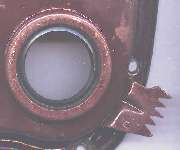 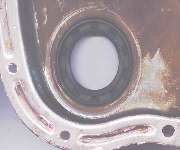
|
This cover has a raised stiffening ridge mid way across the flange in line with the bolt holes. When the traditional oval flat washers are installed, the ends of the flat washers will contact the raised ribs to press the cover against the gasket. The oval flat washers will most likely be bent slightly as the bolts are tightened, but all of this helps to prevent puckering of the cover flange around the bolt holes and improves sealing of the gasket. Some puckering may still occur, so you should still tap the flange flat before installation. When the oval washers are to be re-installed it is also a good idea to tap them flat again with a hammer before installation.
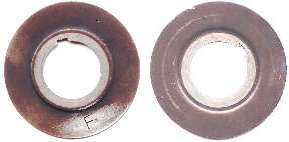 Pictures to the right show the 1965 and later MGB type oil thrower ring. This one is nearly flat with a small step just outboard from the sprocket hub. The ring is stamped with "F" on the front side. When properly installed the flange will be closer to the timing chain (but will not touch the chain). If this one is installed backward the flange might touch and rub on the inside of the cover.
Pictures to the right show the 1965 and later MGB type oil thrower ring. This one is nearly flat with a small step just outboard from the sprocket hub. The ring is stamped with "F" on the front side. When properly installed the flange will be closer to the timing chain (but will not touch the chain). If this one is installed backward the flange might touch and rub on the inside of the cover.
Do not depend on the Moss Motors part numbers to give you the correct oil thrower ring for the MGA. Some years ago someone at Moss apparently had the idea of consolidating inventory (possibly at a time when the MGA part was not available). They substituted the MGB oil thrower ring for use on the MGA. That in itself is a bad idea, because it doesn't work as well with the MGA timing cover. But to make matters worse, they used the prior MGA part number for both the MGA and the MGB parts catalogs. So now when you order the part number for the MGA you get the MGB part, which sort of fits and works with the MGA cover, just not so well. When you order the same part number for the MGB you get the correct part for use with the MGB cover, it just has the older MGA part number on it. If you are changing to the MGB cover, just order the oil thrower ring from Moss and you will get the right one for the MGB cover. Moss does not currently (January 2011) have the correct part for the MGA, but some other vendor may have the correct part.
Addendum February 2013:
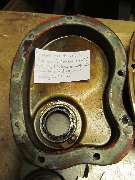
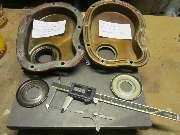
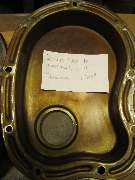
Above center, comparison of two designs. Left is late MGA and early MGB cover with front loading oil seal. Right is late MGB cover with rear loading oil seal. All throwers shown in these pictures are the intermediate style cup shape with offset hub. Do not use the cup shape throwers (early or intermediate) with the late model MGB rear loading cover.
Below left is late MGA and early MGB front loading cover with seal installed and correct intermediate oil thrower ring with cup shape and offset hub. Below center is two sides of the inetermediate thrower with cup shape and offset hub. Below right is a drawing of the early and intermediate style oil thrower rings.
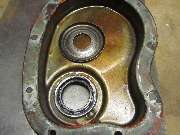
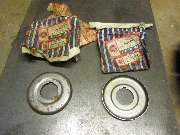
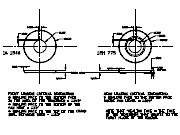
SPL 1500
1A1546 Oil thrower
2A552 Cover - front (with felt seal) [no tensioner]
11G93 Cover - front (with felt seal) com.(e)GB259 [with tensioner]
2K7140 Ring - front cover (felt)
SPL 1600:
1A1546 Thrower - oil fin.(e)16GC/8262 [for felt seal cover]
12H775 Thrower - oil com.(e)16GC/8263 [for rubber seal cover]
11G93 Cover - front fin.(e)16Gc/8262 [with felt seal]
12H771 Cover - front com.(e)16Gc/8263 [with rubber seal]
2K7140 Ring - front fin.(e)16Gc/8262 [felt]
2A939 Seal - front com.(e)16Gc/8263 [rubber}
MGB
12H775 Thrower - oil 18GB to 18GB11850 [also MG Magnette MK III-IV]
12H1740 Thrower - oil 18GB11851 on [flat flange and offset hub]
* 18GB is the first 5-main bearing engine with small flywheel fitted to 3-synchro gearbox. The oil thrower changed to the flat with offset type in middle of 18GB production, matching the shallower cover with rear loading seal.
** When you see: "1A1546 or 12H775 is superseded by 12H1740", it is a joke and a travasty on humanity. The flat edge thrower is absolutely not suitable for earlier engines (unless the later type timing cover is also used). Moss Motors and B&G have been foisting this scam on the public for about 20 years. When Moss changed part numbers to make all MGA and MGB thrower rings the same, they use the late MGA and early MGB part number but supply the late MGB part. The part supplied is not correct for earlier engines.
|
 Picture at right shows the most common timing cover fit to the MGA starting at engine number GB259. The first 158 engines, from GB101 to GB258, did not have a timing chain tensioner. Those early timing covers were a simple pear shape without the small bump on the side. That is the model shown in Section A of the workshop manual. In the early pages of the manual there is no mention of the tensioner, not even in the instruction for installation and alignment of the timing chain. First appearance of the tensioner in the manual is in the illustration of the camshaft and crankshaft and oil pump components. First instruction for the tensioner is in Section A.32.
Picture at right shows the most common timing cover fit to the MGA starting at engine number GB259. The first 158 engines, from GB101 to GB258, did not have a timing chain tensioner. Those early timing covers were a simple pear shape without the small bump on the side. That is the model shown in Section A of the workshop manual. In the early pages of the manual there is no mention of the tensioner, not even in the instruction for installation and alignment of the timing chain. First appearance of the tensioner in the manual is in the illustration of the camshaft and crankshaft and oil pump components. First instruction for the tensioner is in Section A.32. 









 The early MGB timing cover is more common and in more plentiful supply and can also be used on the MGA. Starting with (or slightly before) the 1965 model with 18GB engine, the timing cover is formed differently, with the rubber seal pressed in from the inside of the cover, so the cover must be removed to replace the seal. This cover is also slightly thinner and flat faced with the seal nest extending forward from the face (no large moat around the seal), so you also have to use the different (almost flat) oil thrower ring from the MGB (1965 and later).
The early MGB timing cover is more common and in more plentiful supply and can also be used on the MGA. Starting with (or slightly before) the 1965 model with 18GB engine, the timing cover is formed differently, with the rubber seal pressed in from the inside of the cover, so the cover must be removed to replace the seal. This cover is also slightly thinner and flat faced with the seal nest extending forward from the face (no large moat around the seal), so you also have to use the different (almost flat) oil thrower ring from the MGB (1965 and later). 







